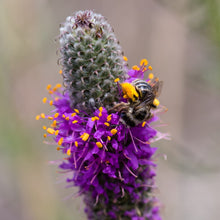The precious magenta tufts of Purple Prairie Clover spike out from a whimsical spray of foliage, attracting an array of bees, moths, and butterflies— hosting in particular the Southern Dogface, California Dogface, and Reakirt’s Blue Butterfly. It is even listed as a superfood for the Rusty Patched bumblebee. The thimble-shaped cone of a flower head has small flowers blooming from the bottom up, rich with nectar. This resilient native plant has a deep taproot (it can grow over six feet long!) that allows it to withstand extreme drought and heat, and so long as it is growing undisturbed and in well-drained soil, the plant should have a long life span. As modern development has disrupted the natural habit of this flower, Dalea purpurea is an excellent prairie restoration plant on lands degraded by strip mining, preventing erosion and fixing nitrogen in the soil. Though enjoyed by many grazing herbivores, too much mammal browsing can be destructive for the propagation of Purple Prairie Clover. Overall though, this plant is a survivor; its seeds can grow after even a century of dormancy. During WWII in England, the plant bloomed back up from bomb craters after having been assumed extinct, likely emerging into the light after years of sleeping deep beneath the soil. This perennial plant can thrive in elevations from 4000-7500 feet.
The genus of this plant is named in honor of the 17th-18th century botanist, Samuel Dale, with the specific epithet meaning ‘purple.’ This was one of the plants collected in the 1804-1806 Lewis and Clark expedition, and two of the original specimens live on in the Lewis and Clark herbarium in Philadelphia. We can learn much about going through life with tenacity and style, doing good along the way, from these incredible legumes.












